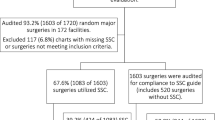Abstract
The implementation of a surgical safety checklist is said to minimize postoperative surgical complications. However, to our knowledge, no randomized controlled study has been done on the influence of checklists on postoperative outcomes in a developing country. We conducted a prospective randomized controlled study with parallel group study design of the implementation of WHO surgical safety checklist involving 700 consecutive patients undergoing operations in our hospital between February 2012 and April 2013. In 350 patients, the checklist was implemented with modifications—the Rc arm. The control group of 350 patients was termed the Rn arm. The checklist was filled in by a surgery resident, and only the participants in the study were blinded. Postoperative wound-related (p = 0.04), abdominal (p = 0.01), and bleeding (p = 0.03) complications were significantly lower in the Rc compared to the Rn group. The number of overall and higher-grade complications (Clavien-Dindo grades 3 and 4) per patient reduced from 0.97 and 0.33 in the Rn arm to 0.80 and 0.23 in the Rc arm, respectively. A significant reduction in mortality was noted in the Rc arm as compared to the Rn arm (p = 0.04). In a subgroup analysis, the number of overall and higher-grade complications per patient with incomplete checklists was higher than that with fully completed checklist group. Implementation of WHO surgical safety checklist results in a reduction in mortality as well as improved postoperative outcomes in a tertiary care hospital in a developing country.





Similar content being viewed by others
References
Weiser TG, Regenbogen SE, Thompson KD, et al. An estimation of the global volume of surgery: a modeling strategy based on available data. Lancet 2008; 372: 139-144.
Sewell M, Adebibe M, Jayakumar P, et al. Use of the WHO surgical safety checklist in trauma and orthopaedic patients. Int Orthop 2011; 35: 897-901.
Gawande AA, Thomas EJ, Zinner MJ, et al. The incidence and nature of surgical adverse events in Colorado and Utah in 1992. Surgery 1999; 126: 66-75.
de Vries EN, Ramrattan MA, Smorenburg SM, Gouma DJ, Boermeester MA. The incidence and nature of in-hospital adverse events: a systematic review. Qual Saf Health Care 2008; 17: 216-223.
Provnost P, Needham D, Berenholtz S, et al. An intervention to decrease catheter-related bloodstream infections in the ICU. N Engl J Med 2006; 355: 2725-2732.
Birkmeyer JD. Strategies for improving surgical quality: checklists and beyond. N Engl J Med 2010; 363: 1963-1965.
Haynes AB, Weiser TG, Berry WR, et al. A surgical safety checklist to reduce morbidity and mortality in a global population. N Engl J Med 2009; 360: 491-499.
Joint Commission. Sentinel events alert-5th December 2001. http://www.jointcommission.org/SentinelEvents/sentineleventsalert/sea-24.htm.
Joint Commission. Sentinel events statistics-December 31, 2006. http://www.jointcommission.org/SentinelEvents/statistics.
Vats A, Vincent CA, Nagpal K, et al. Practical challenges of introducing the WHO Surgical Checklist: UK pilot experience. Br Med J 2010; 340: b5433.
de Vries EN, Prins HA, Crolla RM, et al. SURPASS Collaborative Group; Effect of a comprehensive surgical safety system on patient outcomes. N Engl J Med 2010; 363: 1928-1937.
Charlson ME, Pompei P, Ales KL, et al. A new method of classifying prognostic comorbidity in longitudinal studies: development and validation. J Chronic Dis 1987; 40: 373–383.
Dindo D, Demartines N, Clavein PA. Classification of Surgical Complications: A new proposal with evaluation in a cohort of 6336 patients and results of a survey. Ann Surg 2004; 240: 205-213.
van Klei WA, Hoff RG, van Aarnhem EEHL, et al. Effects of the Introduction of the WHO “Surgical Safety Checklist” on In-Hospital Mortality: A Cohort Study. Ann Surg 2012; 255: 44-49.
Borchard A, Schwappach D, Barbir A, Bezzola P. A Systematic Review of the Effectiveness, Compliance, and Critical Factors for Implementation of Safety Checklists in Surgery. Ann Surg 2012; 256: 925–933.
Haynes A, Weiser T, Berry W, et al. Changes in safety attitude and relationship to decreased postoperative morbidity and mortality following implementation of a checklist-based surgical safety intervention. BMJ Qual Saf 2011; 20: 102–107.
Mazzocco K, Petitti DB, Fong KT, et al. Surgical team behaviors and patient outcomes. Am J Surg 2009; 197: 678-685.
Makary MA, Sexton JB, Freischlag JA, et al. Operating room teamwork among physicians and nurses: teamwork in the eye of the beholder. J Am Coll Surg 2006; 202: 746-752.
Neily J, Mills PD, Young-Xu Y, et al. Association between implementation of a medical team training program and surgical mortality. JAMA 2010; 304: 1693-1700.
Walker IA, Reshamwalla S, Wilson IH. Surgical safety checklists: do they improve outcomes? Br J Anaesth 2012; 109: 47-54.
de Leval MR, Carthey J, Wright DJ, Farewell VT, Reason JT. Human factors and cardiac surgery: a multi-center study. J Thorac Cardiovasc Surg 2000; 119: 661-672.
Urbach DR, Govindarajan A, Saskin R et al. Introduction of surgical safety checklists in Ontario, Canada. N Engl J Med 2014; 370: 1029-1038.
W-Dahl A, Robertsson O, Stefa’nsdo’ ttir A, Gustafson P, Lidgren L. Timing of preoperative antibiotics for knee arthroplasties: improving the routines in Sweden. Patient Saf Surg 2011; 5: 22.
Weiser T, Haynes A, Dziekan G, et al. Effect of a 19-item surgical safety checklist during urgent operations in a global patient population. Ann Surg 2010; 251: 976-980.
Bosk CL, Dixon-Woods M, Goeschel CA, Pronovost PJ. Reality check for checklists. Lancet 2009; 374: 444-445.
Funding
None
Author information
Authors and Affiliations
Corresponding author
Additional information
Department of Surgical Gastroenterology and Liver Transplantation, Sir Ganga Ram Hospital, New Delhi, India, is the department and institution at which the study was done.
The paper is not based on a previous communication to a society or meeting.
Rights and permissions
About this article
Cite this article
Chaudhary, N., Varma, V., Kapoor, S. et al. Implementation of a Surgical Safety Checklist and Postoperative Outcomes: a Prospective Randomized Controlled Study. J Gastrointest Surg 19, 935–942 (2015). https://doi.org/10.1007/s11605-015-2772-9
Received:
Accepted:
Published:
Issue Date:
DOI: https://doi.org/10.1007/s11605-015-2772-9




